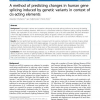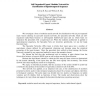246 search results - page 30 / 50 » Learning to Predict Rare Events in Event Sequences |
BMCBI
2010
13 years 7 months ago
2010
Background: Polymorphic variants and mutations disrupting canonical splicing isoforms are among the leading causes of human hereditary disorders. While there is a substantial evid...
IDA
1998
Springer
13 years 7 months ago
1998
Springer
We investigate a form of modular neural network for classification with (a) pre-separated input vectors entering its specialist (expert) networks, (b) specialist networks which ar...
ICML
2010
IEEE
13 years 8 months ago
2010
IEEE
Hidden Markov Models (HMMs) are important tools for modeling sequence data. However, they are restricted to discrete latent states, and are largely restricted to Gaussian and disc...
VC
2008
13 years 7 months ago
2008
Animation authoring involves an author's interaction with a scene, resulting in varying scene complexity for a given animation sequence. In such a varying environment, detecti...
COLT
2000
Springer
13 years 11 months ago
2000
Springer
In the present paper, we present the theoretical basis, as well as an empirical validation, of a protocol designed to obtain effective VC dimension estimations in the case of a si...


